This is common in human to make mistakes likewise we may have made mistakes while filing an Income tax return. It is quite common question, how to revise the income tax return while original income tax return has e filed by the asessee. people want to know the process. In this article We have summersied the process and FAQ about the revise income tax return. Revision of e filed income tax return is as simple as filing of original return. In fact, the same process nothing new. Just for your awareness, an assessment year is a year immediately after the relevant financial year for which the return is e-filed. Every assessee who has filed his income tax return can revise it, also a person who has filed the return after the due date but before the relevant assessment year is allowed to correct the details but this must be done before that 2 year of relevant assessment year.
What is the last date to revise the income tax return?
As per the current update the deadline to revise income tax return (ITR) for fiscal year 2021 -2022 with the assessment year of 2022 – 2023. Currently, to provide an opportunity to correct an error, taxpayers can now file an updated return within 2 years from the relevant assessment year. Taxpayers Can Now File Updated Tax Return Within 2 Years from Relevant Assessment year. If you fail to file the ITR by the due date, you can still file the return called ‘Belated Return’. The belated return can be filed as per section 139 (4) of the Income Tax Act, 1961. However, the assessee would be liable to pay late filing fees and penal interest.
The late fee penalty for filing the ITR after the due date is upto Rs.5,000. Small taxpayers whose total taxable income during the fiscal year under review does not exceed Rs.5 lakh will have to pay a maximum penalty of Rs.1,000 if the ITR is filed after the due date but before the last date.
A Step-By-Step Guide to File Revised Income Tax Return
- Visit the official website, https://incometaxindia.gov.in/Pages/default.aspx
- Log In using user ID (PAN number) and Captcha.
- Now you need to Click on the ‘e-Filing’ menu and select ‘Income Tax Return’.
- Now, you will have to select the Assessment Year, ITR Form number and select ‘Revised’ under ‘Filing Type’.
- Click on ‘Prepare and Submit Online’
- Now under the ‘General Information’ tab, you will have to choose ‘return filing section’
- After that Under that menu, click on ‘revised return’ and under the ‘return filing’ menu, click on ‘revised’.
- Enter the acknowledgement number and Date of Filing (Original).
- Fill in the details and click on ‘Submit’.
- Now, you can e-verify the returns and proceed. Without e-verification IT department will not process ITR (income tax return) without it being e-verified.
Frequently asked questions
Generally, the credit of refund process takes about 20-45 days from the date of e-verification of the income tax return. However, if the acknowledgement has been sent physically to the CPC, it may take a longer time.
As per Section 139(5), an assessee can file a revised return 3 months before the end of the relevant assessment year or before the completion of the assessment, whichever is earlier.
If you are filing revised returns within the due date, there is no limit on the number of revised returns you can submit. But note that you will have to provide complete details of the original ITR every time you file a revised return.
Apart from delay in filing of TDS/TCS return, section 271H also covers cases of filing incorrect TDS/TCS return. In other words, minimum penalty of Rs. 10,000 and maximum penalty of up to Rs. 1,00,000 can be levied if the deductor/collector does not file a TDS/TCS return or files an incorrect TDS/TCS return.
Table of Contents
Toggle


